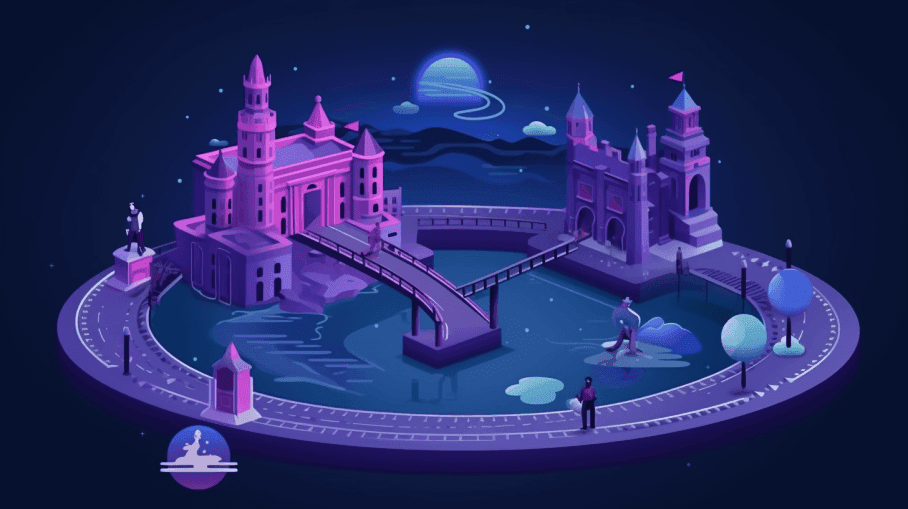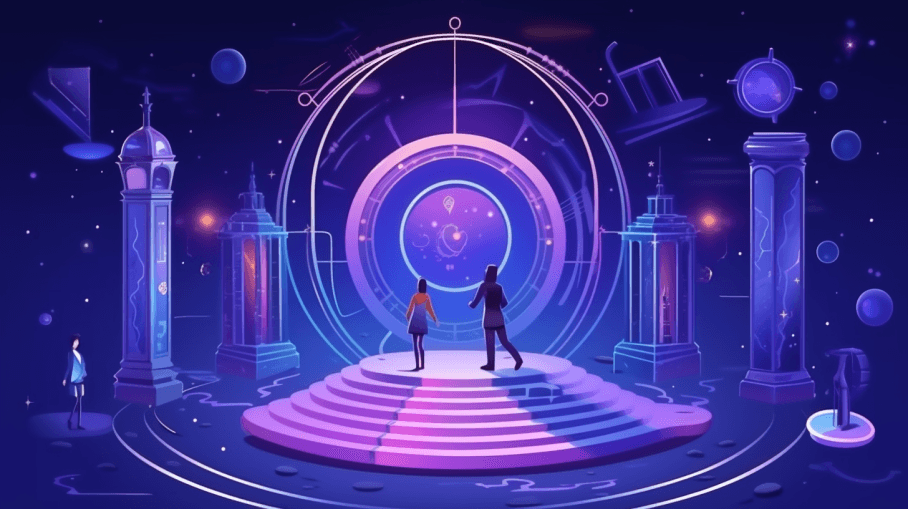Historical Reconstruction: Walking Through Time In Virtual Realities

In the vast landscape of the metaverse, the boundaries between the real and the imagined blur, offering us the chance to traverse centuries within seconds and witness tremendous historical reconstruction.
The evolution of VR technology has given me an opportunity to let curious minds step back in time, explore ancient civilizations, and witness pivotal moments through the lens of immersive experiences.
Join Metastack as we explore the fascinating realm of historical reconstruction, where Virtual Reality breathes life into long-lost eras.
What Is the Purpose of Historical Reconstruction?
Reading about historical events, listening to them, and watching movies gives us a surface-level understanding of history.
However, when you walk into historic sight, your perception of events changes drastically, even for a moment. That's why historical reconstruction has always been a great asset to education.
Nowadays, historical reconstruction is taken to the next level with immersive technologies like VR, AR, and the metaverse. Now, we can see, hear, and feel the events, and they become an actionable part of the specific historical sight of our choice.
To understand how virtual historical reconstruction is possible, getting acquainted with the Virtual Reality itself is essential.
Understanding Virtual Realities
VR is a simulated environment created with the help of computer technology, allowing users to interact with a three-dimensional, computer-generated environment in real-time.
Through VR headsets and other sensory peripherals, users can immerse themselves in a digital world that feels remarkably lifelike, providing a sensory experience that transcends the physical realm.
That's how VR is so good at creating the best historical reconstruction.
Read: How Virtual Reality (VR) and Augmented Reality (AR) Fuels the Metaverse Growth

How Time Travel VR Is Changing the Perception of History?
Time travel has always captivated the human imagination, and VR technology has turned this fantastical notion into a tangible reality.
Time travel VR experiences enable users to experience the most realistic historical reconstruction, transcend the limitations of the present, and journey back to pivotal moments in history.
Whether exploring the majestic pyramids of ancient Egypt or walking through the cobbled streets of medieval Europe, historical reconstruction offers a unique, breathtaking experience.
Here are the two significant benefits of time travel VR down:
Immersive Historical Environments: Time travel VR combines historical research with cutting-edge 3D modeling techniques, recreating ancient cities, historical events, and significant landmarks with remarkable precision.
Interactive Storytelling: Users can interact with historical characters, explore detailed environments, and participate in events, offering a dynamic and engaging learning experience.
As you can see, with these capabilities, time travel VR greatly benefits historical reconstruction. Immersive, captivating, and breathtaking - historical reconstruction has never been more realistic than now.
Read: Storytelling & User Experience In The Virtual Cultural Metaverse
The Significance of Historical Reconstruction and VR
As mentioned, historical reconstruction in VR parallels historians' meticulous research and digital artists' creative prowess.
Through this union, historical sites and artifacts are meticulously recreated in virtual environments, preserving their cultural and historical significance.
Let's take a closer look at the significance of VR historical reconstruction:
Preserving cultural heritage
Preserving historical sites is a pressing concern in the face of modern development and natural erosion:
Virtual Reality is pivotal in preserving cultural heritage by creating digital replicas of endangered or lost historical sites.
These digital recreations serve as a valuable record of our heritage and allow future generations to explore and appreciate these sites long after they have vanished from the physical world.
Educational significance
Historical reconstruction in VR holds immense educational value, providing students, historians, and enthusiasts with a dynamic and engaging medium to explore the past:
Textbooks and lectures often need help to convey the immersive richness of historical contexts. VR bridges this gap by offering an interactive, immersive learning experience that fosters a deep understanding of historical events, cultures, and architectural marvels.
Students can participate in virtual archaeological digs, examine artifacts up close, and gain a firsthand perspective on people's lives from different epochs.
As VR technology advances, the possibilities for historical reconstruction are limitless, promising even more detailed, interactive, and emotionally resonant experiences for users worldwide.

Examples of Historical Reconstruction with VR
Historical reconstruction in VR has brought numerous iconic historical sites and events back to life with unprecedented realism.
Here are some compelling case studies that exemplify the transformative power of historical reconstruction in VR:
The Great Wall of China
Ambitious VR historical reconstruction, this project meticulously recreates the architectural marvel of the Great Wall.
Users can traverse the Wall, exploring watchtowers, examining the intricate details of the bricks, and gaining a deep understanding of its historical significance.
This immersive experience offers a glimpse into ancient China's military strategies and the monumental effort behind this engineering marvel.
Machu Picchu
A UNESCO World Heritage Site, Machu Picchu has fascinated explorers and historians for centuries.
In VR, users can explore this Incan citadel in exquisite detail. They can walk through the stone-built structures, marvel at the precision of the stonework, and immerse themselves in the spiritual aura of the site.
This historical reconstruction provides insights into Incan architecture, culture, and the breathtaking landscape surrounding Machu Picchu.
The sinking of the Titanic
The tragic sinking of the Titanic in 1912 has captivated the world's imagination for generations. VR technology allows users to experience the ill-fated ship's final moments.
With this historical reconstruction, users can explore the opulent interiors, witness the iceberg collision, and even feel the ship's gradual descent into the icy depths of the Atlantic.
This VR reconstruction offers a poignant and immersive glimpse into the lives of the passengers and crew, enhancing our understanding of this historic disaster.
Ancient Rome
Historical reconstruction in VR has brought ancient Rome back to life, allowing users to wander the bustling streets of the Eternal City during its peak.
Users can explore this influential civilization's architectural marvels and social dynamics, from the Colosseum's grandeur to Roman villas's intricacies.
They can witness gladiatorial contests, visit the Roman Forum, and gain insights into the daily lives of ancient Romans, providing a comprehensive view of one of the greatest empires in history.
These case studies demonstrate the diverse applications of VR in historical reconstruction, from ancient wonders to modern tragedies.
Read: Immersive Storytelling Techniques for the Metaverse
Future Trends for Historical Reconstruction in Virtual Realities
The promising advancements on the technological front illuminate the horizon of historical reconstruction in Virtual Reality (VR).
Here are the key trends that are set to shape the future of historical reconstruction in VR:
Artificial intelligence integration
Integrating Artificial Intelligence (AI) will usher in a new era of interactivity in historical reconstruction:
AI-driven interactions enable dynamic conversations with virtual historical figures, providing users with personalized and informative experiences.
Users can engage in dialogues with renowned historical personalities, ask questions, and receive responses based on extensive historical research.
This interactive element will deepen users' understanding of historical contexts and foster a sense of connection with the past, creating a truly immersive and educational experience.
Read: Crafting Personalized Experiences with Metaverse And AI
Haptic feedback
Integrating haptic feedback technology will elevate the immersive experience of historical reconstruction by allowing users to feel textures and sensations within the virtual environment:
Users will experience tactile feedback replicating the sensation of touching different materials when interacting with virtual artifacts and structures.
Whether running their fingers over the rough surface of ancient pottery or feeling the smoothness of polished marble, haptic feedback will provide a tangible and multisensory dimension to historical reconstruction.
This tactile experience will enhance users' engagement with historical objects, creating a more profound connection with the past.
Augmented reality overlays
Augmented Reality (AR) overlays will enable users to blend the virtual and physical worlds seamlessly:
By wearing AR glasses or using AR-enabled devices, users can explore historical sites while receiving contextual information and visual overlays.
These overlays can provide historical facts, architectural blueprints, and interactive elements that enhance the user experience.
Users can see virtual reconstructions overlaid onto the physical remnants of historical reconstruction, offering a unique perspective that bridges the gap between the past and the present.
Multi-sensory experiences
Future developments in VR technology will focus on engaging multiple senses simultaneously:
In addition to visual and tactile feedback, advancements in audio simulation, scent replication, and temperature feedback will create fully immersive multi-sensory experiences.
Users can hear the sounds of bustling ancient marketplaces, smell the fragrances of historical gardens, and feel the warmth of sunlight streaming through historical windows.
These multi-sensory elements during historical reconstruction will transport users to different epochs, evoking a holistic sensory experience that transcends traditional historical education and exploration forms.
Read: How The Metaverse Will Save The World

Conclusion
In Virtual Reality, historical reconstruction has transcended the confines of museums and textbooks, offering us a dynamic and immersive approach to understanding the past.
Time travel VR experiences educate and inspire, fostering a deep appreciation for the rich tapestry of human history. As technology evolves, the line between the present and the past will blur further, enabling us to embark on ever more realistic and enlightening journeys through time.
So, put on your VR headset, step into the past, and let history come alive in ways you've never imagined. The wonders of historical reconstruction await, inviting you to walk through time in virtual realities.
Stay tuned with Metastack to learn all about virtual reality and the metaverse!



